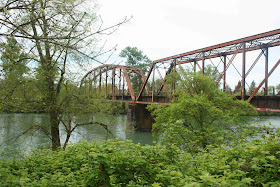As I work toward initial operations on the current
railroad—the “Valley Core"—I find myself diverting into several “side”
projects. Such is the case of the
depot construction for Eugene. It
is not needed directly for operations, but it provides important context for
the tracks currently in place at Eugene.
As I show the layout off to family and friends through the holiday
period, I find the depot would be useful for them to relate to the railroad. Finally, I needed a different project
to lift me out of a bit of a holiday funk.
Eugene depot model in position
on the layout.
My current Eugene depot uses the Walthers “City Station” kit
(933-2904). This is intended as a
long-term stand-in until I finally get around to scratch building a more
accurate depot. The Walthers
structure is the right size and captures the look of the stone and brick depots
along the original Oregon and California (later Siskiyou) Line. These include Medford, Grants Pass,
Roseburg, Eugene and Albany. In
addition to published photos, I consulted photos on Joel Ashcroft’s site: http://spcascades.railfan.net/photosEugene.html and ordered a set of depot photo prints
from the Shasta Division archives from “Photo Bob” Morris: http://www.snowcrest.net/photobob/index.html Out of respect for the intellectual
property rights of both sites and the excellent (commercial) resource provided
by Bob Morris, I provide just links and let the reader judge whether my use of
this kit is a suitable stand-in.
Assembly of the depot is relatively straight forward, though
I will note several things I did to mine.
First, this is a brick structure.
That meant painting the brick siding an appropriate base color (I used
PolyScale Boxcar Red), adding individual brick highlights with Primsacolor
pencils, and applying a mortar treatment.
I began with a thin gray wash (1:3 gray paint:water plus several drops
of Liquitex Flow Aid). Though this
altered the basic brick color a bit, I did not get the desired mortar line
contrast. A second application of
the gray wash was a little better, but still not much contrast. A fellow modeler suggested I go all the
way with a white mortar wash. This
proved to be the solution. Though
the actual mortar on the Eugene depot is gray, one uses white in the model form
to compensate for the small scale—the art of model railroading!
For the window sashes, doors and trim colors, I consulted
the Steam Age Equipment Company SP Common Standard Plan books. Volume 1 lists paint colors for company
buildings. By 1956 (the revision
date on the plan sheet), masonry structures used either gray or tan trim. The photos I looked at showed the trim
color had shifted from darker (bottle green was a previous trim color) to
lighter—gray or tan. I selected
gray based on the darker brick color and looking at the few color pictures I
could find of similar structures along the Cascade and Siskiyou Lines. I stand prepared to receive an
alternative view—inevitable once one makes such a choice. I’ll take such comments under
advisement when I finally tackle a more accurate depot model. Although the standard plans call for
white window sashes, I have no indication of them at Eugene nor on the similar
structure photos I looked at, so windows, doors and trim all received a light
gray color. The roof was painted
SP’s Moss Green (PolyScale Depot Olive).
I installed basic wall partitions between the central
operator bay and the waiting rooms on either side. I also installed a floor. I chose not to light the structure, as I do not intend
conducting night or low light operations on the layout. No further interior detailing was
installed as the structure will be placed two feet away from the aisle. It will serve as a good stand-in.





































